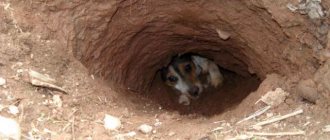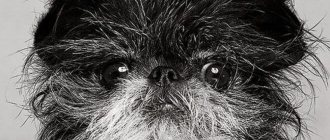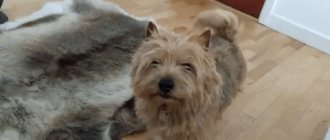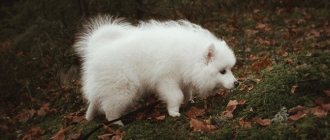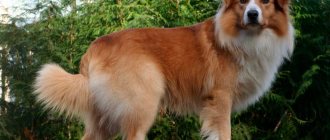Brief description of the breed
What is the actual country of origin?
Great Britain
What is the country of origin according to the FCI?
Great Britain
When did the breed appear?
year 2001
How long does he live?
from 13 to 15 years
How much does a male dog weigh?
from 7 to 9 kg
How much does the bitch weigh?
from 6 to 8 kg
What is the height (height at withers) of a male dog?
from 33 to 37 cm
What is the height (height at withers) of the bitch?
from 31 to 35 cm
How much does a puppy with documents cost?
from 20 to 50 thousand rubles
What is the price of a puppy without documents?
from 50 to 20 thousand rubles
Parson Russell Terrier is a breed of hunting dogs that are relatives of Jack Russell Terriers.
Breeders and owners of these dogs characterize them as gentle, brave, purposeful rodent hunters. Animals are distinguished by activity, endurance, and speed. They are very loyal and will fit perfectly into a family with children.
Purpose and habits
Our hero is a born hunter of burrowing animals, but given the various characteristics of breeding and education, he is now considered a universal companion. These are more working dogs than direct hunting dogs, since they are rarely used for this purpose.
If your four-legged friend sees holes on a walk, don’t be surprised - he will definitely explore them. And don’t forbid him to do this, let the dogs satisfy their instinct
The Parson Russell Terrier is a very active, cheerful and cheerful dog. She can literally race and play all day long. But it should be remembered that the character of the Russell Terrier is flexible only when the pet (especially a puppy) has enough opportunity to splash out its wild energy. Otherwise, the animal can become angry and aggressive towards its own kind, and sometimes towards people.
Video
* We invite you to watch a video about the Parson Russell Terrier . In fact, in front of you is a playlist in which you can select and watch any of 20 videos about a given dog breed by simply clicking on the button in the upper right corner of the window. In addition, the material contains quite a lot of photos. By looking at them you can find out what a Parson Russell Terrier looks like.
In this article:
|
Rate the material!
[Total votes: 1 Average: 5]
To take or not to take?
The Parson Russell Terrier simply amazes with its activity, so neither Jack's nor Parson's litter will suit people who love calm animals. They are too demanding of their owners, although, more precisely, they are too independent. And no one has canceled the hunting instincts either, so you should not keep poultry or rodents in the same room with a boy or girl.
If you decide to make such a quadruple friend, then remember:
- Parson Russell is hyperactive;
- Easy to train, but loves independence;
- Can become aggressive when unattended;
- A real hunter.
We hope that the article was useful to you, and you will write in the comments how interested you are in Parson Russell as a tailed friend.
History of the origin of Parson Russell Terriers
The breed received its modern name only in 1997 in the UK. Before this, Parsons were classified as Jack Russell Terriers. By 2008, dog breeding organizations from around the world officially changed the name of the breed. The history of these animals begins with the priest Jack Russell from Devon, who was a passionate fan of hunting.
In 1819, a vicar purchased a small white and brown dog and named it Trump. It is this female terrier who is the founder of the Parson Russell Terrier family. The priest set out to breed a breed that would have excellent hunting skills for small game, a large supply of energy and a love of adventure.
At the same time, the pets had to develop high speed and be resilient in order to keep up with the horse. And the priest succeeded perfectly. The breeder made a lot of attempts at inbreeding between solid and motley terriers. For him, hunting qualities came first; uniformity in litters was not taken into account.
For the monk, the animal’s courage was important, so that the dog would rush into the fox’s hole for prey without hesitation. By experimenting with fighting breeds, the pastor achieved such characteristics as fearlessness and a strong grip. Church officials were dissatisfied with the priest’s hobby, so they did not give him a title higher than vicar. However, his legacy still brought fame to the minister.
Later, Russell tried to crossbreed his pets with other breeds, but the resulting individuals did not meet the needs of the hunter. Due to unsatisfactory results, work in these directions did not continue. After the end of World War II, dogs gained popularity among hunters on the European continent.
The British Kennel Club recognized the breed on January 22, 1990 as a variety of Fox Terrier. The club rejected the first application, submitted in 1983. The Fédération Cynologique Internationale added the breed to its temporary list on July 2, 1990. Parsons were recognized along with other breeds on June 4, 2001.
Origin and history of the breed
The history of the breed begins in the 19th century. The English priest Jack Russell, under whose leadership another similar breed was bred - the Jack Russell Terrier, was a fan of hunting burrow animals. The pastor set a task: to achieve the creation of another variety of terriers for hunting badgers and foxes. The dog had to be not only smart, active, with excellent hunting qualities, but also sociable, friendly to people, with a non-aggressive character.
As a result of successful selection, a new terrier appeared, the breed was named: Parson Russell. Homeland of origin: Great Britain.
Parson Russell Terrier - description of the breed
In the appearance of dogs, slight deviations from the standard may be allowed, since working qualities come first and are taken into account more than the exterior. In general, the animals are small in size, have a balanced, lean build, a square body with pronounced muscles.
The skull is of medium width, gradually tapering towards the eyes. Cheekbones are practically not visible. The nose is wide, the lobe is large, dark, the nostrils are open. The transition from forehead to muzzle is practically absent. The jaws are powerful. Adults have 42 triangular teeth. The bite is correct, scissor-shaped. Babies have 28 baby teeth.
The lips are black, dry, and fit tightly to the teeth. The eyes are almond-shaped, small, deep-set. Dark colored iris. The ears are of medium size, the skin is of moderate thickness, triangular in shape. The lower end reaches the outer corner of the eye. The free part of the ear hangs forward. The cheeks do not protrude.
The neck is of medium length, muscular, gradually widening towards the shoulders. Covered with thick skin without folds, muscular. The back is strong and straight. The loin is strong and slightly sloping towards the tail. The chest is shallow and does not fall below the elbow line. According to the standard, it should be grasped at the level of the shoulder blades with palms of average size.
The ribs do not protrude, but they should not be flat. Movable, which allows the dog to easily slip into the hole. The abdomen is tucked up, without dewlap. Since this is a burrowing dog, its proportions must be balanced. Limbs are strong and straight. Arranged in parallel. There is no standard for weight.
Ideal parameters for Parson Russell Terriers:
- The height of males at the withers is 35.5 (±2) cm;
- The height of the bitches at the withers is 33 (±2) cm.
The tail had always been docked previously. Now this is an optional procedure. Docked set on high, strong, straight. When in motion it is raised up, when at rest it is lowered. Undocked - medium length, usually straight. Wide at the base, tapering towards the end. High rise. When in motion it is raised up, when at rest it is lowered.
Choosing a puppy
There are many kennels in different countries that specialize in breeding Parson Russell Terriers. It is important to choose a breeder with a good reputation, require a pedigree and vaccination record, and be sure to study PCR analysis to exclude genetic diseases. The puppy must be liked, active, not lethargic, and meet the breed standards. The average cost of a purebred dog is about 20 thousand rubles.
Look at the description of the Scottish Terrier dog breed, and also learn about keeping and training your pet.
The first signs, symptoms and methods of treating inflammation of the paraanal glands in dogs are written on this page.
Follow the link and read about how and how to treat cataracts in dogs.
Popular colors of Parson Russell Terriers
The skin is dense, the coat is coarse, and the undercoat is thick.
There are three types of coat:
- Coarse long hairs. The face has eyebrows, mustache, and beard. Regular trimming is required;
- The coat is of moderate length, lying close to the body. Trimming is also required;
- Short hair.
The coat of all types is straight, bristly, and protects well from getting wet in bad weather. The entire body, including the inner thighs and belly, should be covered with hair. The final type of hair is formed only by the second month of the puppies’ life; this should be taken into account when purchasing. The fluff that appears in the first month of life indicates the wire-haired type.
The long-haired type has a hard pile that does not fit tightly to the body. Because of this, the dogs look quite shaggy. The hair is not very rough to the touch. Intermediate type dogs do not grow eyebrows or a beard. The hair is broken in some places. They fit snugly to the body and do not stick out in different directions.
The smooth-haired type has short hair that lies very close to the skin. They are best suited for hunting, since short hair does not prevent dogs from crawling into narrow holes and getting game from there. Together with the dense undercoat, the hair coat provides excellent protection from bad weather conditions. Thin and soft wool is considered a defect.
The breed cannot boast of a variety of colors.
The following colors exist:
- White with tan (black and brown spots);
- Solid white.
The basis of the color is white. There may be spots on the back, tail and face. White and black, combined with any other shade, is called tricolor. Brindle coloring and spotting covering more than 50% of the body are unacceptable.
Character and habits of Parson Russell Terriers
Animals have a curious character, energy, and love adventure. They love walks in different places and do not tolerate monotonous training. They are restless, explore the area, are interested in the smells and sounds around them, and get to know people with interest.
These dogs love to travel, making them great companions for adventure lovers. Despite the fact that the original purpose of four-legged animals was hunting, in our time dogs are practically not used for these purposes, only as pets.
The creatures are very fond of games and pranks. They quickly become attached to the family and do not tolerate being alone in the apartment for a long time. Excessive fearlessness can be a disservice to the dog. In urban conditions, animals can provoke other dogs, even those significantly larger than their size, to fight.
Owners by nature, four-legged animals require a personal, isolated space in which their sleeping place and individual toys will be located. Because of his love for digging holes, the Parson should be taken out of town and taken to the park. Otherwise, all the pet’s unspent energy will go into damaging household property.
Four-legged animals get along well with children. But how they will get along with other pets is unknown. Perhaps they will become friends, but there is also a possibility that there will be constant squabbles at home. To prevent a dog from showing aggression towards its relatives, constant control over it is needed.
High intelligence allows Parsons to make independent decisions. In addition to charm and playfulness, dogs have qualities inherent in all terriers: a tendency to run away, willfulness, restlessness, adventurism, a desire for pranks, obsession, and cockiness.
Animals are highly trainable, but some qualities prevent them from becoming first-class athletes. Eccentricity and independence sometimes lead to disobedience. If a dog feels needed and cared for by its owner, it will do everything to make the family in which it lives happy.
Character traits and temperament
This is an active, mobile pet that constantly needs company. Such a pet cannot be kept at home alone all day long, although it often does not get along well with other pets. Ideal for large families with children - they will get along well with the terrier and will be able to give him the attention he needs. Like any dog, the Parson is best kept in a private home, but he is quite suitable for living in an apartment, the main thing is proper upbringing.
Individuals of this breed are energetic, there should be a lot of movement, so it takes a long time to walk with them. You can take your pet with you for a run or a bike ride. It is perfect for families who prefer an active lifestyle. However, walking can be a challenge, especially with a young puppy. The dog will be aggressive towards other animals. It is important to keep your terrier on a leash at all times for his safety, and training can also help.
Trainability
This breed is trainable, and you can start training not only a puppy, but also an adult - the Russell will quickly begin to master new commands. He has an obedient and kind character. At the same time, the terrier perfectly distinguishes not only gestures and postures, but also the emotional state of the owner too. The animal is smart and sociable, has excellent orientation and has a good memory. You can train your pet at a dog training center or on your own. If you wish to teach your pet a standard set of commands, it will not take you longer than a few months.
Interesting facts about Parson Russell Terriers
International Breed Day is celebrated on July 2. It was on this day in 1999 that the World Canine Federation officially recognized her. Dog owners and simply lovers of the breed get together, celebrate, and organize competitions between their pets.
These animals are considered the best high jumpers. To date, the Guinness Book of Records has registered a jump of 198 centimeters. The breed is also in the top ten among long-distance runners. Jack Russell was a lover of horse riding and instilled in dogs the ability to tirelessly run after a horse for a long time.
If four-legged dogs are raised in a single-owner household, they will be incredibly selfish. Creatures living with one owner consider themselves the center of the universe and try in every possible way to fill all the owner’s free time. Jealousy can cause them to growl, get angry, or express dissatisfaction in other ways.
Many people confuse Jack Russell Terriers and Parsons. Their most important difference is the height at the withers. If the former reach 30 centimeters in height, then the latter grow up to 36 centimeters. The second difference is the square parson format. Jack Russell Terriers have a longer build.
Dogs are often used to treat depressed people or people with disabilities. Pets will help cope with a bad mood and give the owner a lot of joy and fun. Four-legged animals are used in canistherapy, help improve the abilities of children with cerebral palsy, autism, and turn a withdrawn child into a sociable one.
During his lifetime, the creator of the breed was considered a madman, and his charges were considered defective. The dogs allegedly did not meet hunting standards. However, the animals quickly gained popularity among hunting enthusiasts, thereby proving that the pastor was able to achieve incredible success in his work. The breeder sold his pets many times, keeping only Trump, the first dog.
Pros and cons of Parson Russell Terriers
Dogs are very loving. Therefore, they are not suitable for owners who spend a lot of time outside the home. Animals can play too much due to their nature and accidentally push a small child. But the four-legged animals are strong friends with older children. Excessive energy can be a hindrance for older people.
However, for young people who are fond of sports and lead an active lifestyle, who have sufficient time for their pet, the creatures will become wonderful companions. They quickly get used to any living conditions. They happily accept the owner’s various ideas and always support him in his desire to go on a trip.
The creatures are unpretentious in care; wire-haired individuals do not shed. However, they require serious education. A craving for pranks without training can result in chewed shoes, scratched wallpaper and furniture. Without education, dogs' uncontrollable emotions develop into aggression and anger.
Thanks to its good security qualities, you will always be alerted to possible danger. The creatures will rush to defend their owner without hesitation, even if the attacker is large. If the dog does not feel threatened by a stranger, he will treat the stranger calmly. Loyal creatures will give love to their owner until the end of their days.
The Parsons have a good sense of human mood and do not skimp on reciprocity: they respond to love with love, to hate with hatred. Raising a best friend from a dog is not difficult. The main thing is to give him care, warmth, treat him like a family member, accept all his advantages and disadvantages.
Breeding Parson Russell Terriers
Before buying a dog, you should immediately decide whether it will be used for breeding. If you have no plans to reproduce offspring, it is better to castrate the male immediately, and sterilize the female. These actions will help the animals maintain a balanced character.
Males with O and females with a rating of “very good” are allowed for breeding. Before mating, you must show your pet to an expert at an exhibition. It happens that the descendants of titled parents are not valued highly and are not allowed to breed.
If you decide to start breeding yourself, keep in mind that animals reach puberty at 1 year. However, the full development of the body occurs at the age of two, so the first mating is best done at 2 years of age during estrus, which lasts about two weeks.
If a bitch is brought to an unfamiliar dog, most often she behaves aggressively and growls. The manual method of mating is practiced, in which the dogs are kept on leashes. Experienced males, regularly used for reproduction, do not pay attention to their partner’s aggression. Control mating is carried out after 1 day to predict the ovulation period.
Pregnancy in Parsons lasts about 60 days. However, the first signs of its onset become visible only after a month.
These include:
- Swelling of the nipples - appears at 3 weeks of pregnancy;
- Increased volume in the ribs - in a sitting position, the female looks plump;
- Changes in behavior - loss of appetite, calmness, apathy.
Childbirth in females of this breed is easy and the help of a veterinarian is often not required. With the onset of labor, the wall of the uterus becomes hard and does not allow the droppings to be felt. Usually 4-6 babies are born. Until the end of the birth, it is better to place the puppies separately in a soft cloth. Then place it on the mother's nipple.
Caring for Parson Russell Terriers
Grooming for dogs of this breed is minimal. The hard coat has virtually no odor and does not shed. You can brush it once a week with a stiff brush. White individuals also do not need frequent bathing. Fur has a unique ability to self-clean, so they should only be washed as a last resort. Bitches are bathed after estrus.
Ears and teeth require regular cleaning. Once a week, the animal’s teeth are brushed with a special brush, and the auricle is carefully cleaned with a damp ear stick. Claws are trimmed as they grow. If your pet often walks on asphalt, this procedure may not be performed. Deposits from the eyes should be removed with a cotton swab dipped in warm water.
The ideal living conditions for a parson would be a fenced-off area in a private house. In winter, the animal is moved indoors. A chain or enclosure is not suitable for keeping. The dog needs the opportunity to go out into the yard at any moment. However, even in urban conditions, four-legged animals feel comfortable.
Periodic trimming of animals with long and medium hair will rid the room of hair and give the pet a well-groomed appearance. To live in an apartment, the dog will need at least 2 hours of walks with active games and training. Creatures show curiosity even in a one-room apartment. It’s worth taking this into account and hiding valuables from them.
After purchasing a puppy, you must immediately begin training. Although even an adult terrier is capable of mastering the necessary set of commands. The hunting breed has a good memory and intelligence, so it quickly grasps the rules of behavior. If you want to develop special skills, it is better to seek help from a specialist.
Care and maintenance
Dogs get along well in apartments, but the spaciousness of private areas suits this energetic breed best. It is important for dogs living in apartments to be diaper-trained in the first two to three weeks after moving.
The dogs require no more grooming than any other short-haired breed, which includes regular brushing twice a week. They are not cut or trimmed , they are bathed as needed. Claws are trimmed if the dog does not grind them down during walks. This phenomenon is extremely rare.
Ears are cleaned regularly. Due to its energy, secretions quickly accumulate in the auricle, in which pathogenic bacteria can develop. The dental system is strong, like all hunters, but a preventive examination twice a year by a veterinarian is still advisable. The eyes are examined every day, since Parson Russell Terriers have a breed tendency to ophthalmological diseases.
Diet of Parson Russell Terriers
Every dog owner faces the choice between ready-made food and natural food. And the owner of the parson will have to do it too. One and the second type of nutrition have their pros and cons. Although the creatures are not susceptible to allergic reactions, preference should be given to expensive premium food that does not contain preservatives or dyes.
Since the creatures are excessively active, the calorie content should be high or at least medium. Natural food is healthier than prepared food, but it requires a time investment. The owner must independently create a diet, buy and prepare food.
A pet accustomed to dry food and canned food receives all the necessary microelements. This is very convenient for busy owners. When feeding naturally, it is better to prepare a menu for the whole week at once in order to provide your pet with all the nutrients.
The main part of the diet should be meat. Chicken, lamb, and lean beef are doused with boiling water, but not boiled. Meat should make up at least 40% of the menu. You can supplement your diet with rice, oatmeal, and buckwheat porridge. They are boiled in water because broths do not provide any nutritional benefit to dogs.
Vegetables in the diet should include pumpkin, carrots, zucchini, beets, and greens. Sea fish can be given once a week, as well as offal. Once every 3 days, dogs are offered eggs and fermented milk products. Vitamin supplements should be chosen as recommended by your veterinarian. Despite good digestion, terriers are unable to digest bones.
The following should be strictly prohibited:
- Pork;
- Sweets;
- Flour products;
- Potato;
- Legumes;
- Allergens in the form of nuts, garlic, milk, honey.
Grooming and maintenance
You can keep a Parson Russell both in an apartment and in a house. He lives best in a large family: the terrier is very sociable and active, so this dog is unlikely to be suitable for lonely or elderly people. Be prepared for the fact that any dog will shed and will need to be brushed. With a smooth-haired individual this will take less effort. In addition to grooming, proper nutrition, frequent communication and exercise are important .
How to feed
The diet should include meat and offal. Turkey, rabbit, beef, kidneys, liver, chicken neck will be useful. Sometimes you should diversify your terrier's diet with boneless fish and chicken eggs. The Parson Russell is an active, strong, muscular breed, so the diet should be based on protein. Carbohydrates are also important to maintain activity - Russell eats oatmeal, rice or buckwheat porridge. As for fats, they should be minimized in the diet, so there is no need to overfeed the terrier with lamb or pork. You can partially train your dog to eat dry food.
- 8 signs that you have a serious illness
- 4 ways to slow down brain aging
- 5 cases when you need to apply for pension recalculation
Walking and exercise
The Parson Russell Terrier is an active hunting companion dog. For those who like to spend all their time at home, it is unlikely to be suitable. Regular long walks are essential for her to maintain good physical shape. Without sufficient stress, the animal will weaken and become bored, which can have an extremely negative impact on the animal’s temperament and increase the animal’s aggressiveness.
In good weather, it is highly advisable to walk your adult dog for at least two hours a day. A puppy may require a little less time. In addition, it is worth shortening your walks in conditions of heavy rain, extreme heat or frost. Russell is active, so letting a child walk with him is highly not recommended - children often simply physically cannot hold the animal.
At least a couple of times a week, you should take your puppy on longer, more active walks; for example, he can accompany you while cycling or jogging. It is best to do this in parks in the morning, when there are few people there - this way you can let the Parson off the leash for a while. If you are walking near residential buildings or near a roadway, you need to hold the animal tightly and monitor its behavior.
Diseases and health problems
Animals' immunity is quite strong.
However, certain procedures are required to maintain it:
- Timely vaccination;
- Regular examinations by a specialist;
- Taking vitamins;
- Physical exercise.
The only way to protect your pet from serious viral diseases that the body cannot cope with on its own is vaccination. The first vaccination is given at 2.5 months. At this age, strains of enteritis, plague, parainfluenza, and hepatitis are introduced. After 2 weeks, the leptospirosis vaccine is administered.
At the age of six months it is necessary to get a rabies vaccination. Further vaccinations are carried out once a year. Overall, the breed is considered one of the healthiest in the world. She has no gastrointestinal or heart problems and no neurological disorders. However, genetic diseases are still present.
Parsons have a predisposition to a serious disease - necrosis of the femoral head. This disease manifests itself as lameness and decreased activity. The first symptoms appear at the age of 5-6 years, after which you should immediately contact a veterinarian.
Congenital deafness is typical for white individuals. Also a congenital disease found in children is ataxia. He is characterized by poor coordination. Chaotic movements cannot be treated. As you age, your risk of developing glaucoma increases.
A rare disease found in four-legged animals is a blood clotting disorder. Other genetic predispositions relate to dogs' vision: cataracts, corneal dystrophy, displacement of the eye lens. The average lifespan of creatures is 13-16 years.
Health and heredity
Dogs of this breed are very strong and healthy: they rarely suffer from hereditary diseases. Most Parson Russell Terrier diseases are infectious. This is especially common due to bites from ticks, fleas and mosquitoes. It is completely difficult to protect your pet from such a threat. Nevertheless, when walking in the summer, it is worth treating the fur with repellents, and then carefully inspecting the pet and combing the dog upon returning home.
The most common hereditary disease is necrosis of the femoral head. This disease can appear by the age of five and will require surgical intervention. Sometimes some individuals experience hereditary deafness and mild incoordination. You can encounter these problems only in rare cases. The Parson is considered one of the healthiest dog breeds today.


